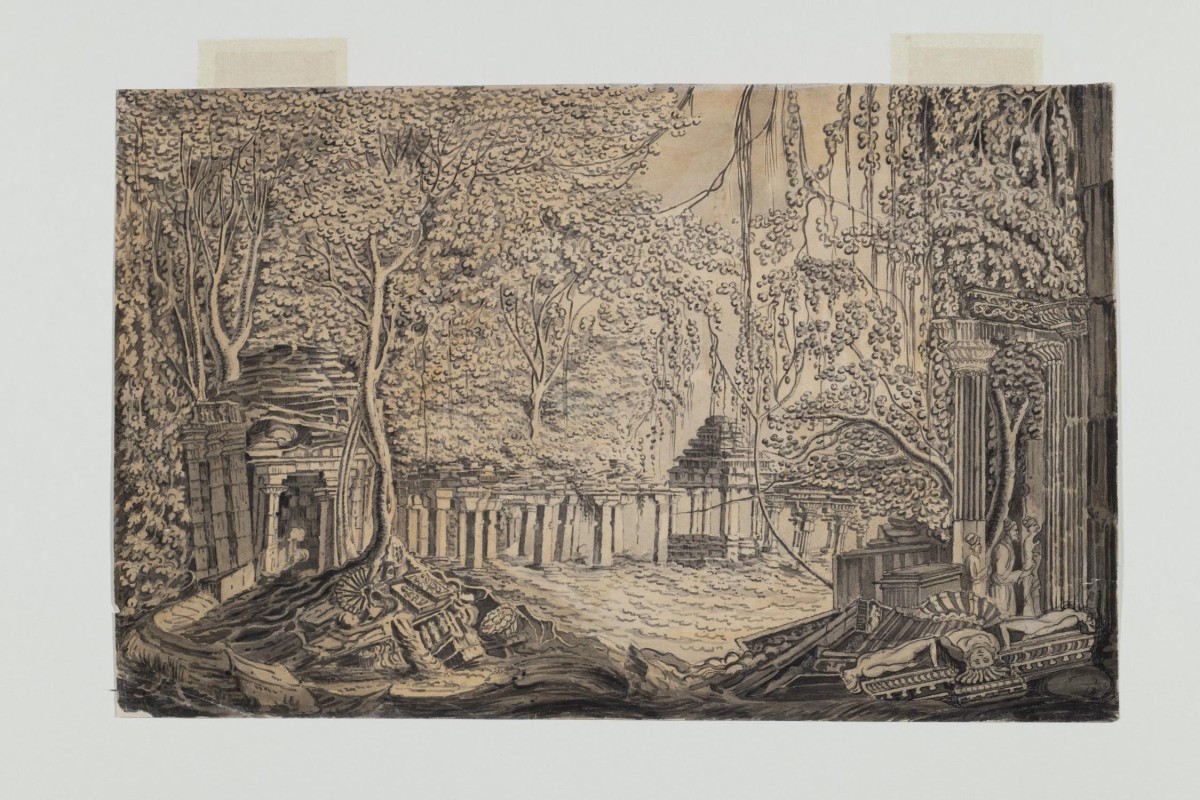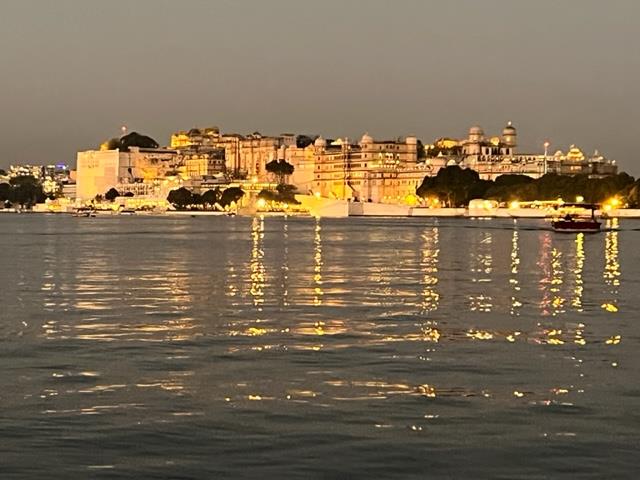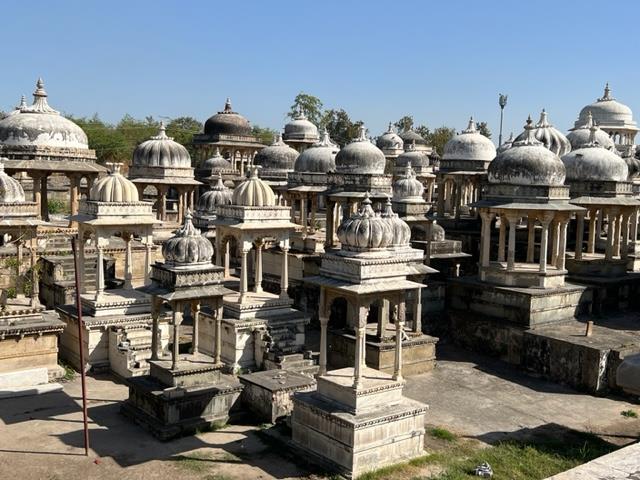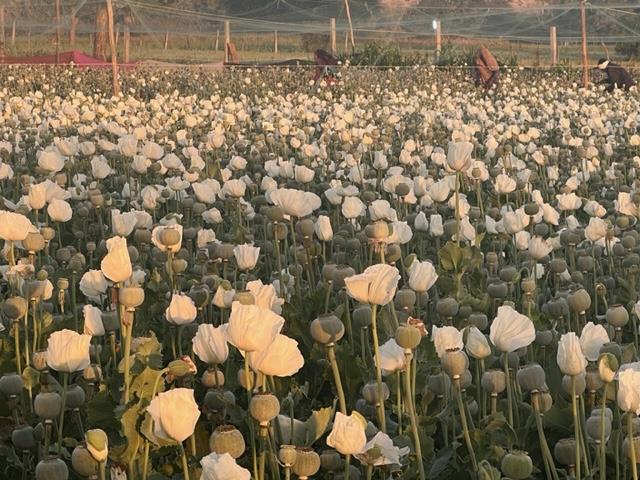Dr Elizabeth Driver – A Bicentenary Tour of the Royal Asiatic Society (Part 1)
Visiting some of the places described by Tod in the Personal Narratives of the Annals and Antiquities of Rajasthan.
Introduction
Col James Tod is, of course, important to us as the author of the Annals and Antiquities of Rajasthan, published originally in two volumes in 1829 and 1832 respectively, and about to be republished with a third volume of additional material prepared by Norbert Peabody. He was also the first librarian of the Royal Asiatic Society so, in this our bicentenary year, it seemed appropriate to follow in his footsteps to some of the well-known and more obscure parts of Rajasthan. In October 2022 I went on a recce with a friend, Susan Haswell, then the group tour took place in February this year.
I want to address two questions. As Freitag suggests, in Rajasthan, Tod is still the “marker and preserver of the bygone glory of the Rajputs.” Until recently, Indian school children read Tod and a copy of the Annals is apparently still a common wedding present in Rajasthan. We met one lucky lady who got three copies. So, my first question is: who was he and, as one friend asked me, how come an obscure British officer became so important in Rajasthan?
My second question is the obverse: why did it all go so badly wrong? I will explain what I mean by that in a moment, but first, to answer both questions, we must look at the state of Rajasthan at the beginning of the 19th century.
Rajasthan at the beginning of the 19th century

Marathas and Pindaris
The Marathas had been raiding north-west India, into Malwa and Gujarat, throughout the 18th century and the decline in Mughal power to check them had led to incursions into neighbouring Rajasthan. They became involved in Rajput internecine disputes, mainly over succession, at the invitation of the Rajput rulers themselves, who ended up promising to pay them enormous sums of money, which they then couldn’t pay, resulting in territory being ceded.
The Marathas were assisted by the Pindaris, described as “irregular troops attached to the Maratha armies, used mainly for plunder.” Tod often used the term “freebooter” to describe them. One of their leaders, Amir Khan, had assisted the Marathas, but then skilfully exploited differences between the Rajput rulers, supporting whoever seemed expedient at the time. At the end of the Pindari war in 1818, the British bought him off by making him Nawab of Tonk, where he continued to cause trouble.
The end result of all this was that the land was laid waste, villages burnt, trade and commerce made impossible and there was a massive migration of population out of Rajasthan.
As the British expansion came up against Maratha ambitions, three Anglo-Maratha wars were fought between the East India Company and the Maratha Empire. The third war (1817-1819) resulted in the break-up of the Maratha empire and Scindia surrendered Rajasthan to the British and agreed to help them fight the Pindaris. Tod’s map had proved a crucial strategic tool in this war. Tod was attached to the court of Scindia as the commander of the British escort, effectively to keep an eye on him.
The Rajputs realised that the British would protect them from the Marathas and between 1803 and 1823, all the Rajput states signed treaties with the EIC.
Rajput internecine disputes/ The Ten year war
Another major contributing factor in the poor state of Rajasthan was the widespread strife between the rulers and the local nobles. In Mewar, the treaty with the EIC included an understanding, known as the Kaul-Nama, between the local nobles and Bhim Singh. The rush to sign it was led by the chief of Begu, who we will meet.
In addition, Jaipur, Jodhpur and Udaipur were engaged in what is sometimes known as the Ten Year War, ostensibly over the hand of the daughter of Bhim Singh of Udaipur, the (of course) beautiful and tragic Krishna Kunwari.
Tod tells us: “Krishna Kunwari (the virgin Krishna) was the name of the lovely object, the rivalry for whose hand assembled under the banners of her suitors (Jagat Singh of Jaipur and Man Singh of Marwar), not only their native chivalry, but all the predatory powers of India; and who, like Helen of old, involved in destruction her own and rival houses.”
The situation escalated in part due to the involvement of the ubiquitous and perfidious Pindari, Amir Khan, who initially supported Jaipur and besieged Jodhpur, but then switched sides and was dispatched in 1810 by Man Singh to Udaipur to ‘persuade’ Bhim Singh that his daughter should marry Man Singh.
The story ended badly when her father was advised that the only way out of the impasse was the death of the princess. Her uncle is said to have administered poison, which she took willingly to save her family and land, though it was only with the third cup that she died.
Tod’s role
When we first meet him on his travels, at Bamolia in 1807, Tod was Commander of the British escort to the court of Scindia. The court was peripatetic, which gave Tod the opportunity to explore, record and map large parts of Rajasthan. Scindia, as we have seen, signed a treaty with the EIC, and Tod was involved in the negotiation and implementation of further treaties with Rajput rulers
Tod was appointed – and dismissed – as Political agent as follows
| States | Appointed | Dismissed |
| Western Rajput States: Mewar, Kota, Bundi, Sirohi | 1818 | All except Mewar April 1822 Resigned from Mewar June 1822 |
| Marwar | 1819 | November 1819, at the request of the Jodhpur court |
| Jaiselmer | 1821 | 1822 |
His first appointment was in 1818 and by April1822, only Udaipur remained.
Freitag points out that Tod’s work as political agent was unique in that he approached it as a historian, on one occasion describing 400 years of history as background to a report on an 1818 border dispute (Sirohi). There is no question that he was fascinated by the Rajputs and sought a link between their martial characteristics and his own Scottish ancestors. He formed close relationships with some, particularly in Udaipur and in Bundi. His attitude to the Rajputs is clear from the dedication of Volume I of the Annals.
It should not be forgotten that he was a product of the Romantic era: Wordsworth, Keats, Shelley, Robert Burns, Walter Scott were all contemporaries. Antiquarianism was all the rage. The Rajput construct of valour, chivalry and sacrifice appealed to Tod and he identified with them and tended to ignore their less admirable qualities. The romantic influence of the time can also be seen in Waugh’s drawings.

Udaipur
We started, as Tod did, in Udaipur.

Tod first visited Udaipur with Scindia in 1806 when an attempt was made to end the conflict between Mewar and the Marathas. Tod was struck by the romantic appeal of the Rana, Bhim Singh, and wrote in the Annals: “The impression made on the author upon this occasion by the miseries and the noble appearance of this ‘descendant of a hundred kings’ was never allowed to weaken, but kindled an enthusiastic desire for the restoration of his fallen condition, which stimulated his perseverance to obtain that knowledge by which alone he (Tod) might be enabled to benefit him.” He got his chance twelve years later when he returned to Udaipur as Political Agent. By this time, there was an even worse mess: a civil war between two rival Rajput factions had rendered the court unable to function and the nobles had usurped much of the crown lands and were extorting money from the Rana. Because the British were primarily interested in Mewar as a bulwark against the Marathas and as a source of revenue, Tod was instructed to ‘re-establish the Rana’s authority and settle the country.’

House of Rampyari
Tod’s success in restoring the Rana’s position, lands and revenues unsurprisingly made him something of a hero to Bhim Singh, considered a weak ruler, much under the influence of women, notably his mother and her friend Rampyari. The previous Maharana was still a minor when he succeeded his father so his mother assumed the role of regent and it was she who raised the intelligent and ingenious Rampyari to the role of de facto ruler of Mewar. Bhim Singh was also a minor when he succeeded and the same arrangement continued, even into his majority. It was in Rampyari’s orchards, now long since built on, that Tod set up his camp and lived for three years. We were lucky enough to be shown the house, with its temple, by its present owners.

City Palace
The City Palace is vast, with each ruler adding to it and altering it so that it is difficult to be sure how it would have looked when Tod was there. We were welcomed by Bhupendra Singh Auwa, the director, and his staff and they told us of their research on Tod’s house and Carey’s grave since my last visit.

Tod’s first journey
Tod set out from Udaipur on the first of his journeys on October 11 1819.He was clearly well settled in: “We had our palace in the city, our cutter on the lake, our villa in the woods, our fairy islands in the waters; streams to angle in, deer to shoot, much, in short, to please the eye and gratify the taste:- yet did ennui intrude, and all panted to escape from the ‘happy valley’ to see what was in the world beyond the mountains.” It was quite an entourage: Tod, his cousin Captain Patrick Waugh, Waugh’s ensign, Lt Carey, and Doctor Duncan and also the man Tod describes as his guru, a Jain called Gyanachandra. They were accompanied by two companies of foot and sixty of Skinner’s Horse, the ‘yellow boys’
Tod’s house
They set off at 5am and reached camp by 8. “ The spot chosen, and where I afterwards built a residence, was a rising ground between the villages of Merta and Toos, sprinkled with trees and, for a space of four miles, clear of the belt of forest which fringes the granite barriers of the valley… to the south, a mile distant, we had the Berach river, abounding in trout; and the noble lake whence it issues, called after its founder, the Udai Sagar, was not more than three to the west.”
I was particularly keen to find this house. He refers to it again on his return from his first journey, when he had to wait at Merta for a few days to be formally welcomed back to Udaipur by Bhim Singh. “Here we amused ourselves in chalking out the site of our projected residence on the heights of Tus, and in fishing in the source of the Berach.”
The building we located is between Merta and Toos, at Dabok. It is now a Teacher Training College and we were welcomed with ceremony by its Principal, Professor Saroj Garg, and her staff. I am convinced that the building we visited is the same as that seen in ruins in a photograph taken in 1893. This is particularly apparent on the upper floor, now reached via an adjacent building. The interior is bleak.

We will return to Tod’s house, and the final poignant reference, right at the end of the Personal Narratives.
Ahar

Like Tod, we visited the royal cenotaphs at Ahar. “Ar or Ahar, near where we encamped, is sacred to the manes of the Princes of Udaipur, and contains the cenotaphs of all her kings since the valley became their residence; but as they do not disdain association, either in life or death, with their vassal, Ar presents the appearance of a thickly crowded cemetery…” The cenotaph of Amar Singh contains a memorial to the 18 wives who committed sati. There were many other individual sati stones at Ahar, like this one.

Greeting by Maharana Bhim Singh on Tod’s return to Udaipur.
At last, the signs were auspicious and Bhim Singh rode out to welcome Tod back. I think this passage shows well the closeness of the relationship between the Maharana and Tod: “The Rana came… The most hearty welcomes were lavished upon us all… it was not a meeting of formality, but of well-cemented friendship.”

Castle Bijaipur and some agriculture

Tod never went to Bijaipur, although it is marked on his map. It is a small walled fort with a modest palace, one of the first to become a hotel. It is surrounded by farmland so we had a chance to see the villages and fields at close quarters.
The agricultural practices of Rajasthan clearly fascinated Tod and he tells us a good deal about what crops were grown at the various times of the year. Mostly nothing has changed, though Susan and I happened to see the peanut harvest in October. I am not aware of any mention of peanuts in the Annals, though it is thought that they were introduced to India by the Jesuits in the 17th century.

What is most interesting is what he has to say about opium. He says: “A slight sketch of the introduction and mode of culture of this drug, which has tended more to the physical and moral degradation of the inhabitants than the combined influence of pestilence and war, may not be without interest.” He suggests that medicinal use dates back to antiquity but that abuse is relatively recent, or not more than three centuries back.
He goes on to describe the method of cultivation and harvest: “The cutting instrument consists of three prongs…The wound is made from the base up and the milky juice which exudes coagulates on the outside. Each plant is thrice pierced on three successive days, the operation commencing as soon as the sun begins to warm. On cold mornings, when it congeals rapidly, the coagulation is taken off with a scraper.”
Tod is damning about the British exploitation of opium: “If the now paramount power, instead of making a monopoly of it, and consequently extending the cultivation, would endeavour to restrict it by judicious legislative enactments, or at least reduce its culture to what it was forty years ago, generations yet unborn would have just reason to praise us for this work of mercy. It is no less our interest than our duty to do so, and to call forth genuine industry, for the improvement of cotton, indigo, sugar-cane, and other products which would enrich instead of demoralizing, and therefore impoverishing, the country. We have saved Rajputana from political ruin; but the boon of mere existence will be valueless if we fail to restore the moral energies of her population;”

Some country forts and Rajput hospitality
In this section of my talk, I will describe some smaller forts in the countryside where we were lavishly entertained by the descendants of the rulers with whom Tod worked.
Bamolia – the tale of Tod’s boots
Strictly speaking, Bamolia should not have been part of this tour, which was otherwise based on the Personal Narrative sections of the Annals, as Tod visited it in 1807. However, it is associated with such a funny incident and so well illustrates what Tod was doing in the earlier part of his career that a visit was irresistible and Maharaj Abhimanyu Singh Bambulia gave us such a warm welcome in October that we had to go back.
Tod describes his visit:
“In 1807, when the author, then commencing his career, was wandering alone through their country, surveying their geography, and collecting scraps of their statistics, he left Scindia battering Rathgurh, and was returning home unattended at a brisk canter, when, as he passed through the town of Bamolia, a party rushed out and made him captive, saying that he must visit the chief. Although much fatigued, it would have been folly to refuse. He obeyed, and was conveyed to a square, in the centre of which was an elevated chabootra or platform, shaded by the sacred tree. Here, sitting on carpets, was the chief with his little court. The Author was received most courteously. The first act was to disembarras him of his boots; but this, heated as he was, they could not effect: refreshments were then put before him, and a Brahmin brought water, with a ewer and basin for his ablutions. Although he was then but an indifferent linguist, and their patois scarcely intelligible to him, he passed a very happy hour, in which conversation never flagged.”
We were welcomed by Abhimanyu, his two daughters and the family pug. We were shown a painting which he had commissioned from a Kota miniature painter of the scene where Tod, finally divested of his boots, is seated with the Raja on the chabootra. After a delicious lunch and exchange of presents, we too assembled on the chabootra.
Banera – a story of lost pistols
Tod described Banera when he visited it in early December 1820 as “… one of the most imposing feudal edifices of Mewar and its lord one of the greatest of its chieftains.” He goes on to explain how it was only by chance that one of two sons born to Rana Raj on the same day but of different wives became the ruler of Mewar and the other the chief of Banera. Consequently, even today, on succession to the gaddi of a new Raja of Banera, the Maharana of Mewar sends the ceremonial sword to Banera, unlike the other Mewari nobles who have to go to Udaipur for formal investiture. The new Raja then goes to Udaipur and the Maharana honours him by receiving him at the city gate.
Tod said of his meeting with Raja Bhim “I had a good opportunity of observing the feudal state and manners of these chiefs within their own domains during a visit of three hours at Banera”. So did we. We were met at the elephant gate by Raja Gopal Charan Singh Sisodia Banera, the 14th Raja Sahib and, escorted by a herd of goats, a trumpeter announced our arrival at the gate of the palace.

The description of the conversation with Raja Bhim gives some insight into how Tod operated. The raja asked Tod’s advice as his ‘adopted brother’ on matters of domestic and rural economy, a dispute over a marriage settlement, bad relations between the Raja and his vassals. “All these arbitrations were made without reference to my official situation, but were forced upon me merely by the claims of friendship; but it was a matter of exultation that enabled me to make use of my influence for the adjustment of such disputes, and for restoring individual as well as general prosperity.”
Rana Bhim presented Tod with gifts then “My friend accompanied me to my tents, when I presented to him a pair of pistols…”
Unfortunately, the pistols have recently been stolen from the armoury of the police station in Bhilwara. Gopal’s father used to go from time to time to clean them but, since his death in 2021, they had not been seen. Gopal had invited the press to hear the story and get our comments. Alison is quoted in a Hindi newspaper as saying that the theft “was like tearing the pages out of a history book”. Here we are in the drawing- room, surrounded by Banera ancestors, some still clinging to the walls, others not.
We then were taken to the modern palace by the lake and given an excellent lunch cooked by Gopal’s uncle and parted, as Tod had done “with mutual satisfaction, and I believe, mutual regret.” The pistols have not been recovered.
Begu – a visit to not see a gateway

We had to go to Begu because it was the scene of one of the most dramatic incidents in the Annals, which occurred in February 1822, described by Tod with charming, and unusual, self-deprecation.
“The chances were nine hundred and ninety-nine to one that I ever touched a pen again. Two days ago, I started, with all the ’pomp and circumstance’ befitting the occasion, to restore to the chief the land of his sires, of which force and fraud had conspired to deprive them during more than thirty years. The old castle of Begun has a remarkably wide moat, across which there is a wooden bridge communicating with the town.” The rest of Tod’s party had crossed the bridge and entered the castle. The mahout told Tod that there would not be space to admit Tod’s elephant and howda through the gate. “But I heedlessly told him to drive on, and if he could not pass through, to dismount. The hollow sound of the bridge, and the deep moat on either side, alarmed the animal, and she darted forward with the celerity occasioned by fear, in spite of any effort to stop her. As I approached the gateway, I measured it with my eye, and expecting inevitable and instantaneous destruction, I planted my feet firmly against the howda, and my forearms against the archway, and, by an almost preternatural effort of strength, burst out of the back of the howda; the elephant pursued her flight inside, and I dropped senseless to the bridge below.”
Tod was taken to his camp and put to bed. The Rawat ordered that the gate be demolished, saying “he could never have looked on it with complacency, since it had nearly deprived of life one who had given life to them.” This was a reference to the fact that the Marathas under Scindia had taken over Begu and were exacting a heavy payment. This was brought to an end by the treaty with the EIC, which Begu was the first to sign.
We were received by Rawat Ajai Singh Ji Begu. The main palace is enormous with stables and abandoned wings, He told us there are eight palaces at Begu, all in various states of ruination. The most romantic was the Rajgarh lake palace, with its own temple. He was still grieving over the destruction of the French furniture and Belgian glass of his grandparents’ time and it was hard not to feel sorry for him. We presented him with a copy of the Juki and in the end he was reluctant to let us go.
Part 2 will be posted next week.

